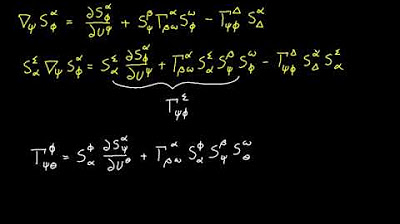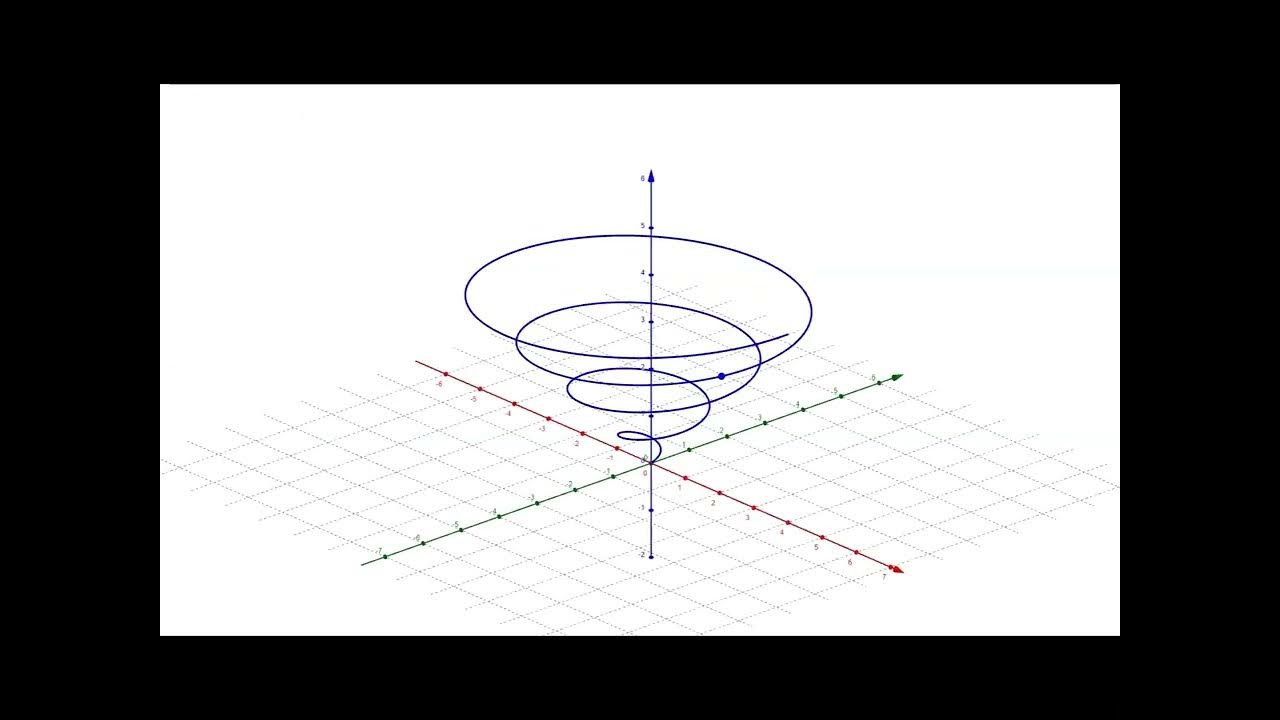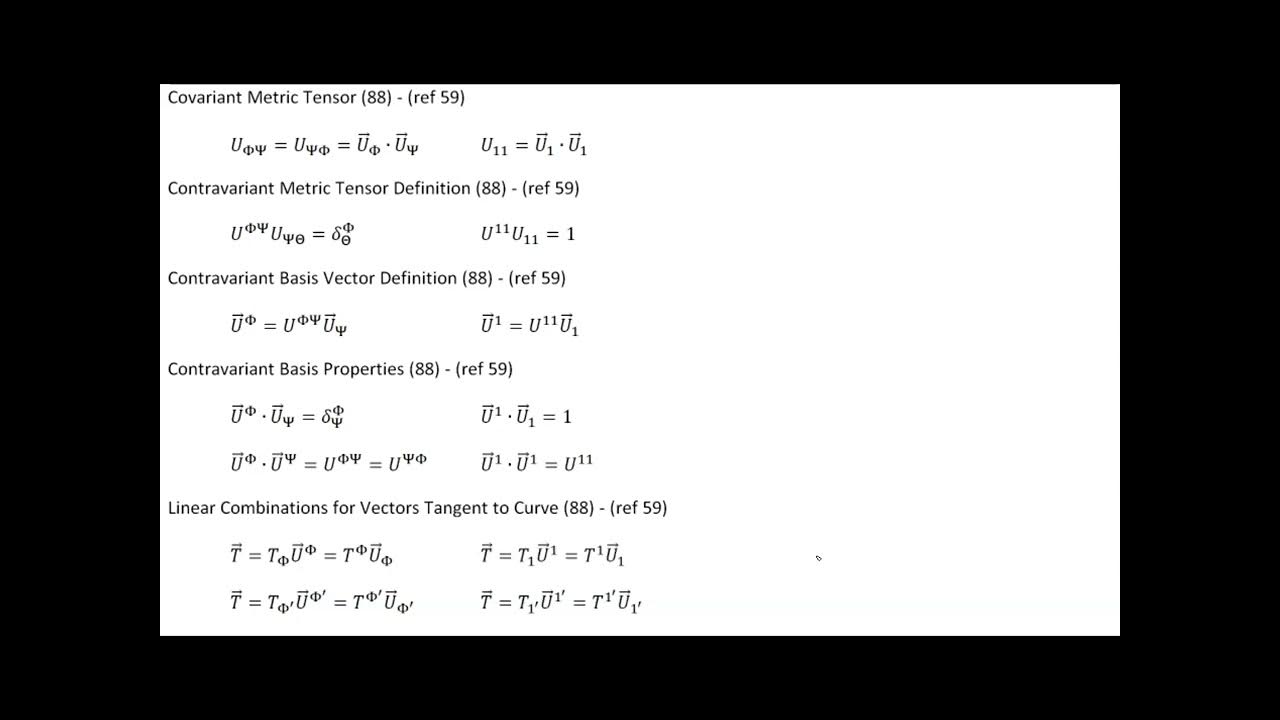Video 92 - Curves Embedded in Surfaces
TLDRThis video, part of a series on tensor calculus, explores the analysis of curves embedded in surfaces, contrasting with the simpler case of curves in Euclidean space. It discusses two approaches: treating the curve as a 1D sub-manifold in a 2D plane or as a hypersurface. The video emphasizes deriving relationships without relying on position vectors, making the results universally applicable to any surface, curved or flat. It concludes by highlighting the intrinsic properties of surfaces, such as the metric tensor, as key to understanding embedded curves, without needing extrinsic curvature information.
Takeaways
- 📚 The video is part of a series on tensor calculus, focusing on analyzing curves embedded in surfaces, following previous discussions on surfaces and curves in 3D Euclidean space.
- 📐 Two approaches are presented for analyzing a curve in a plane: treating it as a 1D sub-manifold in a 2D space, or as a hypersurface with a code dimension difference of one.
- 🔍 The video explains that traditional methods for curves in Euclidean space can be applied to a curve in a plane by substituting z-coordinates with surface coordinates (s-coordinates).
- 🔄 An alternative method involves using the concept of a hypersurface, where the ambient space is the plane and the curve is the hypersurface, with appropriate substitutions for coordinates and shift tensors.
- 📈 The script discusses the covariant metric tensor for the curve, which can be expressed in terms of the covariant metric tensor of the surface and the shift tensors.
- 🚫 It is noted that the traditional approach does not work for curves embedded in curved surfaces due to the inability to define a position vector on a curved surface.
- 🔗 The video introduces the concept of shift tensors and how they relate the curve to the ambient space, the surface to the ambient space, and the curve to the surface.
- 🔑 The script derives relationships for curves embedded in surfaces without relying on a position vector, making the results applicable to both flat and curved surfaces.
- 📝 The video concludes that the relationships derived for embedded surfaces apply to curves embedded in surfaces, regardless of whether the surface is curved, based on intrinsic properties like the metric tensor.
- 🧠 The final point emphasizes that the analysis of curves embedded in surfaces is intrinsic, relying on the surface's metric tensor and the parametric relationship between s and u coordinates, without the need for extrinsic curvature information.
Q & A
What is the main topic of this video in the series on tensor calculus?
-The main topic of this video is the analysis of curves embedded in surfaces, specifically how to approach the mathematical analysis of such configurations.
What are the two approaches mentioned for analyzing a curve embedded in a simple plane?
-The two approaches are: 1) treating the curve as if it were in a Euclidean space and replacing the z-coordinates with surface coordinates, and 2) treating the curve as a hypersurface with the plane as the ambient space and making appropriate substitutions.
Why can't we define a position vector on a curved surface?
-A position vector is not defined on a curved surface because it requires an origin point within the ambient space, which is not well-defined in the context of a curved surface.
What is the significance of the covariant metric tensor in the analysis of curves embedded in surfaces?
-The covariant metric tensor is significant because it allows for the expression of the curve's properties in terms of the surface's properties, making it possible to analyze the curve without direct reference to the ambient space's geometry.
How does the video script demonstrate the generalizability of the analysis for curves embedded in surfaces, regardless of whether the surface is curved or flat?
-The script demonstrates generalizability by deriving expressions strictly from chain relationships and known results about curves and surfaces in three-dimensional space, without referencing a position vector, thus showing that the results are true for all surfaces.
What is the role of shift tensors in the analysis presented in the video script?
-Shift tensors are used to relate the curve to the ambient space, the surface to the ambient space, and the curve to the surface. They are essential in deriving the relationships and properties of the curve embedded in the surface.
Why is it important to establish a position vector with an arbitrary origin within the ambient space when analyzing a curve?
-Establishing a position vector with an arbitrary origin is important because it allows for the definition of covariant basis vectors for the curve, which are derived from the partial derivatives of the position vector with respect to the curve's coordinates.
How does the script handle the transition from analyzing curves in a plane to analyzing curves on a curved surface?
-The script transitions by using the chain rule and relationships between different shift tensors to derive expressions that do not rely on the position vector, thus making the analysis applicable to both flat and curved surfaces.
What is the significance of the contravariant metric tensor in the context of this video script?
-The contravariant metric tensor is significant as it is derived from the covariant metric tensor and is used to further analyze the properties of the curve embedded in the surface, such as the volume element and other geometric properties.
How does the script conclude that the derived relationships for curves embedded in surfaces are intrinsic and not dependent on extrinsic curvature information?
-The script concludes this by showing that the analysis is based solely on the surface's covariant metric tensor and the parametric relationship between the surface and curve coordinates, without any reference to how the surface is embedded in the ambient space.
Outlines
📚 Tensor Calculus for Curves in Planes
The script introduces the analysis of curves embedded in surfaces, starting with simple planes. It discusses two approaches: treating the curve as part of the Euclidean space or as a hypersurface. The first method involves replacing the z-coordinates with surface coordinates, while the second treats the curve as having a co-dimension of one with the plane. The script emphasizes that these methods yield identical results and that the analysis can be extended to curved surfaces by using relationships derived from previous videos.
🔍 Advanced Analysis for Curves in Curved Surfaces
This section delves into the complexities of analyzing curves when the ambient space is a curved surface, rather than a plane. It explains that defining a position vector on a curved surface is not possible, necessitating a different approach. The script revisits previous expressions for the surface covariance metric tensor and the covariant metric tensor for the curve, and uses these to derive relationships between different shift tensors. This leads to a general result that applies to any surface, regardless of whether it is curved or flat.
🌐 Deriving General Results for Curves in Surfaces
The script presents a derivation that does not rely on a position vector, making the results applicable to both flat and curved surfaces. It shows how to derive the covariant metric tensor for a curve from the known results of the ambient space and surface. The process involves substituting expressions and using the chain rule for shift tensors. The result is a general expression for the curve's covariant metric tensor that is independent of the surface's curvature.
📐 Christophel Symbols and Curve Derivatives
The script continues with the derivation of the Christophel symbols for a curve embedded in a surface, starting with an expression from a previous video. It uses the chain rule and shift tensors to express the Christophel symbol in terms of the ambient space's symbols and the surface's metric tensor. The process involves expanding terms using the product and chain rules, and then simplifying the expression to reveal the relationship between the curve's and surface's Christophel symbols.
🔄 Intrinsic Properties of Curves in Surfaces
This paragraph focuses on the intrinsic properties of curves embedded in surfaces by deriving expressions without reference to the position vector. It discusses the implications of these derivations for the contravariant metric tensor, volume element, and other properties of the curve. The key takeaway is that these properties are generally true for all surfaces, not just planes, and are derived from the surface's covariant metric tensor and the parametric relationship between the s and u coordinates.
🧠 Final Thoughts on Curves in Surfaces Analysis
The final paragraph summarizes the video's content, emphasizing the generalizability of the derived relationships for curves in surfaces. It reiterates that the analysis is based on intrinsic properties, such as the surface's covariant metric tensor, and does not require knowledge of extrinsic curvature or how the surface is embedded in the ambient space. The script concludes by highlighting the importance of understanding these intrinsic relationships for analyzing curves in any type of surface.
Mindmap
Keywords
💡Tensor Calculus
💡Euclidean Space
💡Sub-manifold
💡Covariant Basis Vector
💡Shift Tensor
💡Hypersurface
💡Tangent Plane
💡Normal Vector
💡Covariant Metric Tensor
💡Christoffel Symbol
💡Intrinsic Curvature
Highlights
Introduction to analyzing curves embedded in surfaces, contrasting with previous videos on surfaces and curves in 3D Euclidean space.
Two approaches to analyzing a curve in a simple plane: using the plane as the ambient space or treating the curve as a hypersurface.
Substitution method for deriving curve equations by replacing z-coordinates with surface coordinates and shift tensors.
The concept of code dimension and its role in treating a curve as a hypersurface within a plane.
Tangent plane and normal vector definitions for a curve embedded in a surface, distinguishing between surface and curve normals.
Method of substitution applied to derive results for curves in surfaces, avoiding the need for a position vector.
Establishing a position vector for a curve in a surface and deriving covariant basis vectors.
Chain rule expansion for covariant basis vectors involving shift tensors and surface coordinates.
Derivation of the covariant metric tensor for a curve based on the surface's metric tensor and shift tensors.
Analysis of the limitations of the position vector approach on curved surfaces and the need for an alternative method.
Expression derivation for the surface covariance metric tensor as a function of z-coordinates and its relation to curve coordinates.
Chain rule application to connect different shift tensors between z-coordinates, curve, and surface coordinates.
Inversion of shift tensor relationships to find an alternative expression for the curve's covariant metric tensor.
General result derivation for curves on surfaces, independent of whether the surface is curved or flat.
Christoffel symbol computation for curves based on the ambient space's symbols and shift tensors.
Substitution of chain rule relationships into the Christoffel symbol expression to generalize the result for any surface.
Final derivation showing the equivalence of expressions for curves on surfaces, regardless of the surface's curvature.
Conclusion emphasizing the intrinsic nature of the analysis, requiring only the surface's metric tensor and parametric relationships, not extrinsic curvature information.
Transcripts
Browse More Related Video

Video 93 - Geodesic Curvature Tensor

Video 90 - Embedded Curves - Part 2

Tensor Calculus Lecture 14e: Non-hypersurfaces - Relationship Among Curvature Tensors 2

Video 88 - Embedded Curves - Part 1

Tensor Calculus Lecture 8: Embedded Surfaces and the Curvature Tensor

Tensor Calculus Lecture 14c: Non-hypersurfaces - Relationship Among The Shift Tensors
5.0 / 5 (0 votes)
Thanks for rating: